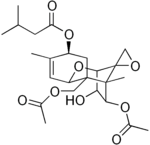T-2 mycotoxin: Difference between revisions
ArmbrustBot (talk | contribs) m →External links: removing category per Wikipedia:Categories for discussion/Log/2013 September 21, removed: Category:Chemical compounds found in Ascomycota using AWB |
Jaydubya93 (talk | contribs) noted dead reference link |
||
| Line 4: | Line 4: | ||
| verifiedrevid = 438853897 |
| verifiedrevid = 438853897 |
||
| Name = T-2 |
| Name = T-2 |
||
| Reference = <ref>[http://www.cbwinfo.com/Biological/Toxins/T2.html T-2 Toxin: essential data]</ref> |
| Reference = <ref>[http://www.cbwinfo.com/Biological/Toxins/T2.html T-2 Toxin: essential data]</ref> |
||
| ImageFile1 = T-2 mycotoxin.png |
| ImageFile1 = T-2 mycotoxin.png |
||
| ImageSize1 = 150px |
| ImageSize1 = 150px |
||
Revision as of 23:46, 9 April 2014
This article needs additional citations for verification. (October 2008) |

| |

| |
| Names | |
|---|---|
| IUPAC name
(2α,3α,4β,8α)-4,15-bis(acetyloxy)-3-hydroxy-12,13-epoxytrichothec-9-en-8-yl 3-methylbutanoate
| |
| Other names
T-2 Toxin
Fusariotoxin T 2 Insariotoxin Mycotoxin T 2 | |
| Identifiers | |
3D model (JSmol)
|
|
| ChEMBL | |
| ChemSpider | |
| ECHA InfoCard | 100.040.255 |
PubChem CID
|
|
| RTECS number |
|
CompTox Dashboard (EPA)
|
|
| |
| |
| Properties | |
| C24H34O9 | |
| Molar mass | 466.527 g·mol−1 |
| Insoluble | |
Except where otherwise noted, data are given for materials in their standard state (at 25 °C [77 °F], 100 kPa).
| |
T-2 is a trichothecene mycotoxin. It is a naturally occurring mold byproduct of Fusarium spp fungus which is toxic to humans and animals. The clinical condition it causes is alimentary toxic aleukia and a host of symptoms related to organs as diverse as the skin, airway, and stomach ingestion may come from consumption of moldy whole grains. T-2 can penetrate into and permeate through the human skin.[2] Although no significant systemic effects are expected after dermal contact in normal agricultural or residential environments, local skin effects can not be excluded. Hence, the skin contact with T-2 should be limited.
History
Consideration by Russian scientists of the possible usefulness of T-2 mycotoxin as a biological weapon followed an observation that, after a spring harvest delayed by World War II, flour contaminated with Fusarium was produced and distributed in bread, causing significant morbidity and mortality.[citation needed] T-2 has also been suggested as a cause of the Plague of Athens (430 BC).[citation needed] T-2 is an infrequent contaminant in animal feed.
T-2 was proposed as a cause of Gulf War syndrome for some United States troops exposed to mortar shells containing T-2 shot by Iraqi forces during the Persian Gulf War. Also, the substance was considered in the investigation of the poisoning of Viktor Yushchenko during his campaign in the Ukrainian presidential election, 2004, though doctors now believe it was the dioxin TCDD.
See also
References
- ^ T-2 Toxin: essential data[dead link]
- ^ Boonen, Jente; Malysheva, Svetlana V.; Taevernier, Lien; Diana Di Mavungu, José; De Saeger, Sarah; De Spiegeleer, Bart (2012). "Human skin penetration of selected model mycotoxins". Toxicology. 301 (1–3): 21–32. doi:10.1016/j.tox.2012.06.012. PMID 22749975.
USAMRIID's Medical Management Of Biological Casualties Handbook
